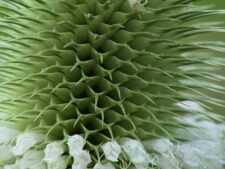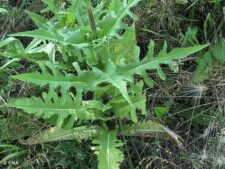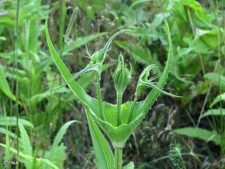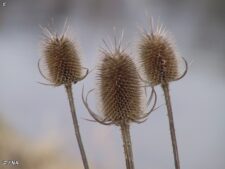
CUT-LEAVED TEASEL
Dipsacus laciniatus
TEASEL FAMILY (Dipsacaceae)
 Identification
Identification
- Flowering time - July, August, September
- Common on FF floodplain - Rare at NW
- Cylindrical flower head with ring(s) of small white flowers
- Large, cut leaves which surround the stem forming a cup
- Spiny, pointed bracts at the base of the flower head
This invasive biennial was introduced from Europe. The first year a rosette of large, deeply cut leaves forms (C). The second year prickly stems up to 6 feet or taller carry opposite, clasping leaves which form prominent water-collecting cups. An emerging, second-year plant is shown at (D). The mature plant stems end in cylindrical heads of small white flowers (A,B). Just below the flower head thin, lance-shaped bracts surround the stem (A). These can be seen throughout winter on the dried seed heads (E). Identified by the large cut leaves and the lance-shaped bracts usually shorter than the mature head.
Occurs near water on flood-plains and waste ground, flowering from July through September. At Fontenelle Forest, common and spreading rapidly on the floodplain, but it is now being controlled by pulling. At Neale Woods, currently still rare around the parking lot.
Cut-leaved Teasel is often found in cemeteries, believed related to its common use in floral arrangements. It can also be carried to new sites by vehicles or mowing equipment.
A related species, Common Teasel (Dipsacus fullonum), occurs elsewhere in Nebraska but has not been seen at Fontenelle Forest or Neale Woods. It has undivided leaves and most often lavender or purple flowers.
The content of NatureSearch is provided by dedicated volunteer Naturalists of Fontenelle Forest who strive to provide the most accurate information available. Contributors of the images retain their copyrights. The point of contact for this page is: Roland Barth.




